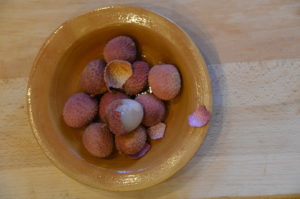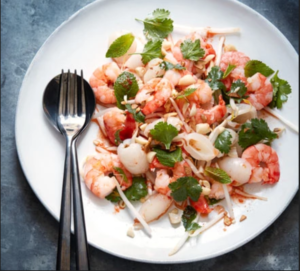Lucious lychees are in season in the UK in the darkest winter months. If you have tried them, you are likely to love them. If you haven’t, you have a treat in store. Literally crack open one of these little packages of gently blushing nom-nom to find out for yourself.
A refreshing Thai recipe for a salad using prawn and lychee: https://www.bbcgoodfood.com/recipes/thai-prawn-lychee-salad
Lychee are one of the most popular fruits of SE Asia and one of the most flavoursome fruit in the world. The lychee is a round-heart shape and can be as big as a golf ball. The skin is quite thin and slightly brittle, and can range in texture from rough to slightly spiky, and in colour from pale green, to pale pink, to deep red.
Lychee is also called Chinese strawberry because it is originated from China and also looks at first glance a bit like a strawberry. Varieties of lychee include Emperor fruit, Mauritiu, Sweet Heart, Brewster, Haak Yip and Bengal. China, Thailand, India and Vietnam are the current leading producers of Lychee. Particularly, China has been cultivating for over 2300 years.
The skin of a lychee can be peeled off quite easily, with practice, leaving the juicy, white, slightly translucent flesh. Each fruit has an elongated, shiny brown stone inside which varies in proportion to the flesh. This is often a key determinant of quality, whereby varieties and locations producing fruit with small stones are much prized.
 The fruit originated in China’s south eastern provinces of Guangdong and Fujian and is from the familySapindaceae, which also contains the other SE Asian fruits the longan and rambutan.
The fruit originated in China’s south eastern provinces of Guangdong and Fujian and is from the familySapindaceae, which also contains the other SE Asian fruits the longan and rambutan.
“Lychee are one of the best tasting fruits in the world,” says Nick Ball, editor of the Good Fruit Guide. “The succulent, juicy, their white flesh is full of tropical, exotic flavour and the perfumed aroma is intoxicating. The fruit has an attractive aroma, and, on eating, this translates into a sumptuous, succulent, perfumed deliciousness. They are also very high in vitamin C. Lychee should look fresh and plump, and without signs of bruising, softness, visible juice on the outside or any mould growth. Colouration of the skin does not give indication of internal eating quality and varies according to the variety, some have a light pink or red hue, others have an unexciting greenish peel.”
Duck or prawn?
Lychee can be refrigerated for two or three days but should be warmed to room temperature before consumption otherwise the flavour is muted, which would be a pity! Lychees are usually for sale in UK with fruit from South Africa and Madagascar from December to end of February/early March depending on harvests, then again around May/June with fruit from Mexico and China. Then, there’s a little flush of fruit available from Israel in September.
As well as being delicious on their own, they can be used in recipes, particularly from Thailand. A quick Google and you’ll find recipes for Thai red curry with duck and lychee, or Thai prawn and lychee salad.
So, if you’ve not tried them, give them a go. You might find a nice surprise in side.
With thanks to Nick Ball, editor of the Good Fruit Guide, who spends his career as a technical expert in the fruit sector. The Good Fruit Guide website is devoted to informing consumers in the United Kingdom about the best tasting fruit on sale in supermarkets, and, by extension, in independent grocery stores and markets.
Nutrition (1 cup serving = 190g peeled, stone removed): Very high vitamin C: 226%*; High riboflavin 7% dv; Low calories: 6% dv (66kcal/100g). Medium Glycaemic Load: 10 (less than 10 = low effect on blood sugars). (Source: USDA SR-21). In addition: Iron 7.3%, 2.5g fibre; 1.6g protein; 30g carbs (28g of which are sugars); 125 calories.
*Daily Value expressed as a % of a 2000kcal per day diet.

